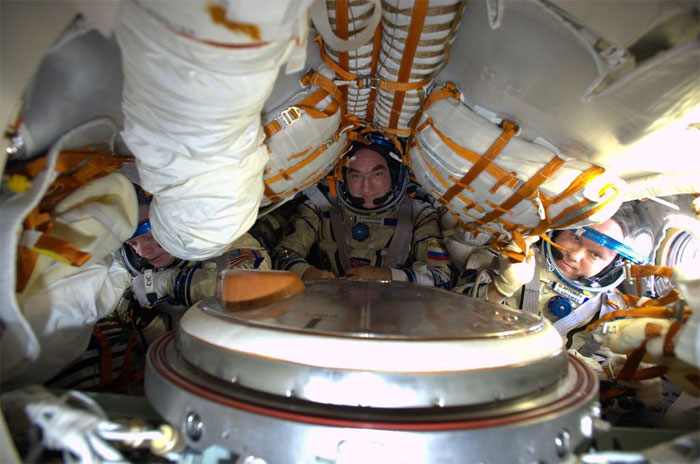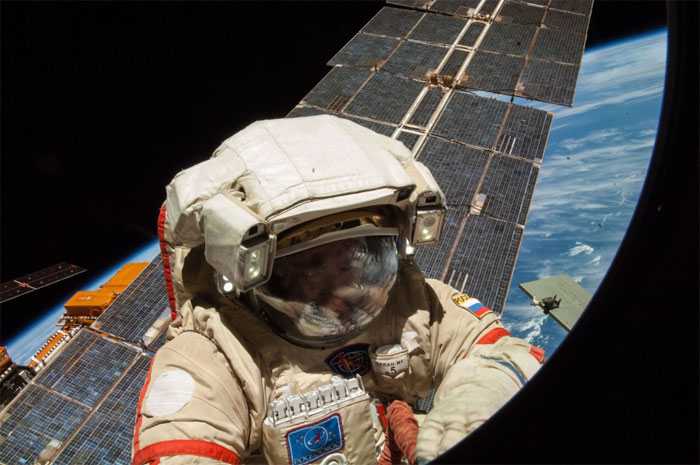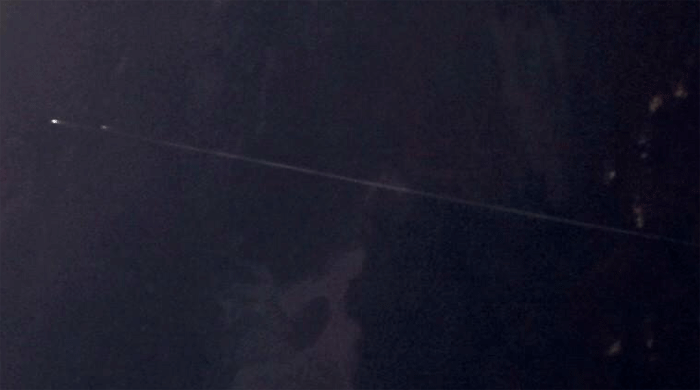.

Flight Engineer Alexander Gerst tweeted this photo of Expedition 40 Commander Steve Swanson (left), Soyuz Commander Alexander Skvortsov (center) and Flight Engineer Oleg Artemyev checking out their Sokol suits inside the Soyuz TMA-12M spacecraft.
.
Science and Departure Preps for Station Crew
Expedition 40 Commander Steve Swanson of NASA and his team of five flight engineers tackled a range of science experiments and supported an upgrade of the International Space Station’s computers Tuesday, all while preparing for next week’s journey back to Earth for half of the crew after nearly six months in space.
Swanson began the workday by setting up some acoustic dosimeters that he and cosmonaut Max Suraev will wear to track the noise levels they are exposed to for the next 24 hours.
The commander then moved on to the Skin B study as he tested the skin on his forearm with several dermatology tools. Skin B investigates the accelerated aging of skin that seems to occur during spaceflight. Results from this study will improve the understanding of the mechanisms of skin aging as well as provide insight into the aging process of similar body tissues.
Afterward, Swanson joined cosmonauts Alexander Skvortsov and Oleg Artemyev in their Soyuz TMA-12M spacecraft docked to the Poisk Mini-Research Module-2 to conduct leak checks of the Sokol launch and entry suits that the three will wear for the return to Earth. Swanson, Skvortsov and Artemyev are slated to undock from the station on Sept. 10 at 7:02 p.m. EDT for a parachute-assisted landing in the steppe of Kazakhstan less than 3 ½-hours later. They have been aboard the station since March 27.
With an eye toward the departure, Skvortsov and Artemyev also spent some time in the morning conducting some preliminary Lower Body Negative Pressure training. The two cosmonauts took turns donning a special outfit that simulates the effects of gravity by drawing fluids to the lower half of the body. In addition to conditioning cosmonauts for the return home, this device provides Russian researchers with data to predict how the cosmonauts will react to the full force of Earth’s gravity at the end of their mission.
Quelle: NASA
.
Update: 8.09.2014
.
Astronaut trio to return after six months on International Space Station

Russian cosmonaut Alexander Skvortsov, performs maintenance and retrieves science experiment packages during a spacewalk on Aug. 18. Skvortsov, along with two other astronauts return to Earth on Sept. 10. Credit: NASA
Three astronauts will return to Earth next week, capping off a six-month stay on the International Space Station.
The members of ISS Expedition 40, including NASA Commander Steve Swanson and Russian cosmonauts and flight engineers, Alexander Skvortsov and Oleg Artemyev, will land in Kazakhstan on Sept. 10, NASA officials said in a press release.
The parachute-assisted landing will happen on a landscape similar to the US’s Great Plains region.
The trio spent six months doing maintenance on the orbiting laboratory, collecting data and conducting experiments in hopes of advancing technologies from weather forecasting to human medicine, according to the expedition’s mission.
Crew members also performed in-flight experiments, including evaluating the XSENS ForceShoe system as a possible way to measure the impact of exercise on specific joints in the body. The data collected will be used to shape exercise regimens created for astronauts to help stave off bone and muscle mass loss during missions. It can also be used to create exercise routines for people who have been restricted from exercise due to age, injury or other factors.
When living in space, astronauts must maintain a consistent exercise routine to avoid muscle atrophy. Studies have shown that microgravity causes astronauts to experience up to a 20 percent loss of muscle mass on spaceflights lasting five to 11 days, NASA said.
To exercise, astronauts do strength training with Advanced Resistive Exercise Devices (AREDs), which simulate the experience of lifting weights on Earth and allows astronauts to do squats, bench and shoulder presses in space.
Cycle ergometers and treadmills on the spacecraft also allow astronauts to do leg exercises and work on cardiovascular fitness and muscle endurance.
Swanson, Skvortsov and Artemyev launched from the Baikonur Cosmodrome in Kazakhstan on the Soyuz TMA-12M spacecraft, headed for the International Space Station, on Mar. 25.
The spacecraft’s landing will be broadcast online by NASA Television from 9:15 p.m. to 11 p.m. (EST) on Sept. 10.
Quelle: PBS
.
Update: 9.09.2014
.
Space crew returning from ISS guaranteed safe welcome on Earth
The Soyuz will land 148km south-east of Zheskazgan (Kazakhstan) scheduled for 6.25am Moscow time on September 11
A space crew - Russian cosmonauts Alexander Skvortsov, Oleg Artyomyev and NASA astronaut Steven Swanson, have been guaranteed safe welcome on Earth when they return from the ISS back to the Earth in a descending apparatus of the Soyuz-TMA-12M spaceship on September 11.
"Around 200 army servicemen, fourteen helicopters Mi-8, three planes AN-13 and AN-26 and six cross-country vehicles will ensure safety of the space crew when the landing apparatus touches down 148 kilometers south-east of Zheskazgan (Kazakhstan) scheduled for 6.25am Moscow time on September 11," assistant troops commander of the Central Military District Colonel Yaroslav Roschupkin told ITAR-TASS.
"Aviation forces, search and rescue facilities of the Central Military District have arrived to the assigned area where the descending apparatus is to touch down. Emergency rescue groups on board cross-country vehicles and helicopters with a special equipment on board have been deployed in the main and reserve areas of landing," Colonel Roschupkin said.
Quelle: ITARTASS
.
Update: 10.09.2014
.

NASA astronaut Steve Swanson handed over command of the International Space Station to Max Suraev Tuesday at 5:15 p.m. EDT. Swanson and his Expedition 39/40 crewmates, Alexander Skvortsov and Oleg Artemyev, are due to undock their Soyuz on Wednesday at 7:01 p.m., landing in Kazakhstan about 3-1/2 hours later. NASA TV coverage of hatch closure begins at 3:15 p.m. and returns for undocking at 6:45 p.m. Landing coverage begins at 9:15 p.m. with deorbit burn scheduled at 9:30 p.m. and landing at 10:23 p.m.
Quelle: NASA
..
Update: 11.09.2014
.
Space Station Expedition 40 Crew Returns to Earth, Lands Safely in Kazakhstan

Three crew members from the International Space Station returned to Earth Wednesday after 169 days of science and technology research in space, including a record 82 hours of research in a single week. Expedition 40 Commander Steve Swanson of NASA and Flight Engineers Alexander Skvortsov and Oleg Artemyev of the Russian Federal Space Agency (Roscosmos) touched down in Kazakhstan at 10:23 p.m. EDT Wednesday, Sept. 10 (8:23 a.m., Sept. 11, in Dzhezkazgan).
.
Three crew members from the International Space Station (ISS) returned to Earth Wednesday after 169 days of science and technology research in space, including a record 82 hours of research in a single week, which happened in July.
Expedition 40 Commander Steve Swanson of NASA and Flight Engineers Alexander Skvortsov and Oleg Artemyev of the Russian Federal Space Agency (Roscosmos) touched down southeast of the remote town of Dzhezkazgan in Kazakhstan at 10:23 p.m. EDT Wednesday, Sept. 10 (8:23 a.m., Sept. 11, in Dzhezkazgan).
During their time aboard the space station, the crew members participated in a variety of research focusing on Earth remote sensing, human behavior and performance and studies of bone and muscle physiology.
One of several key research focus areas during Expedition 40 was human health management for long duration space travel as NASA and Roscosmos prepare for two crew members to spend one year aboard the orbiting laboratory in 2015.
During their time on the station, the crew members orbited Earth more than 2,700 times, traveled more than 71.7 million miles and welcomed five cargo spacecraft. Two Russian ISS Progress cargo spacecraft docked to the station bringing tons of supplies in April and July. The fifth and final European Space Agency (ESA) Automated Transfer Vehicle also launched to the station in July with the spacecraft bearing the name of Belgian physicist Georges Lemaitre, who is considered the father of the big-bang theory.
SpaceX launched a Dragon cargo spacecraft to the station in April, the company's third of at least 12 planned commercial resupply missions. In July, Orbital Sciences’ Cygnus spacecraft completed its third of at least eight resupply missions scheduled through 2016 under NASA's Commercial Resupply Services contract.
During his time on the complex, Swanson ventured outside the confines of the space station for a spacewalk to replace a backup computer relay box that unexpectedly failed. Skvortsov and Artemyev conducted two spacewalks during Expedition 40, totaling 12 hours and 34 minutes.
The space station is more than a scientific research platform. It also serves as a test bed to demonstrate new technology. Even routine tasks, such as monitoring and operating the carbon dioxide removal system, provides valuable data for next-generation life support systems. Carbon dioxide removal from the pressurized compartments of the station proved to work differently in space than predicted by ground tests. The crew also saw the arrival of the Haptics-1 experiment, part of an effort to develop technology that would allow an astronaut in orbit to control a robot as it explores its target, such as an asteroid or Mars, during future human exploration missions.
Having completed his third space station mission, Swanson now has spent a total of 196 days in space. Skvortsov has accumulated 345 days in space on two flights, and Artemyev accrued 169 days in space on his first mission.
Expedition 41 now is operating aboard the station with Max Suraev of Roscosmos in command. Suraev and his crewmates, Flight Engineers Reid Wiseman of NASA and Alexander Gerst of ESA, will tend to the station as a three-person crew until the arrival in two weeks of three new crew members: Barry Wilmore of NASA and Alexander Samokutyaev and Elena Serova of Roscosmos. Wilmore, Samokutyaev and Serova are scheduled to launch from Kazakhstan Thursday, Sept. 25.
.

Quelle: NASA
.
Soyuz TMA landing module with three ISS crew members land in Kazakhstan
Russian cosmonauts Alexander Skvortsov, Oleg Artyomyev and NASA astronaut Steven Swanson have worked aboard the ISS for about 170 days

he landing module of Russia’s Soyuz TMA-12M manned spaceship with three members of the International Space Station (ISS) crew has landed in Kazakhstan early on Thursday, a spokesman for the mission control centre told ITAR-TASS.
“The module landed in the designated area in the steppe some 148 kilometres southeast of Kazakhstan’s city of Dzhezkazgan at 06:23 a.m. Moscow time,” the spokesman said, adding that rescuers were heading for the landing site.
The three ISS crew members, Russian cosmonauts Alexander Skvortsov, Oleg Artyomyev and NASA astronaut Steven Swanson have worked aboard the ISS for about 170 days.
The remaining crew onboard the International Space Station include Russian cosmonaut Maksim Surayev, who took over the command from Swanson, NASA astronaut Reid Wiseman and European Space Agency astronaut Alexander Gerst.
The upcoming space expedition will take off on September 26 from the Baikonur space centre onboard a Soyuz TMS-14M spaceship. The crew will include Russian cosmonauts Yelena Serova, Aleksandr Samokutyayev and NASA astronaut Barry Wilmore.
Quelle: ITARTASS
.

"Our view of the picture perfect reentry of TMA-12M," Expedition 41 flight engineer Reid Wiseman wrote on Twitter from aboard the International Space Station on Wednesday, Sept. 10. (NASA)
Quelle: NASA
4854 Views
